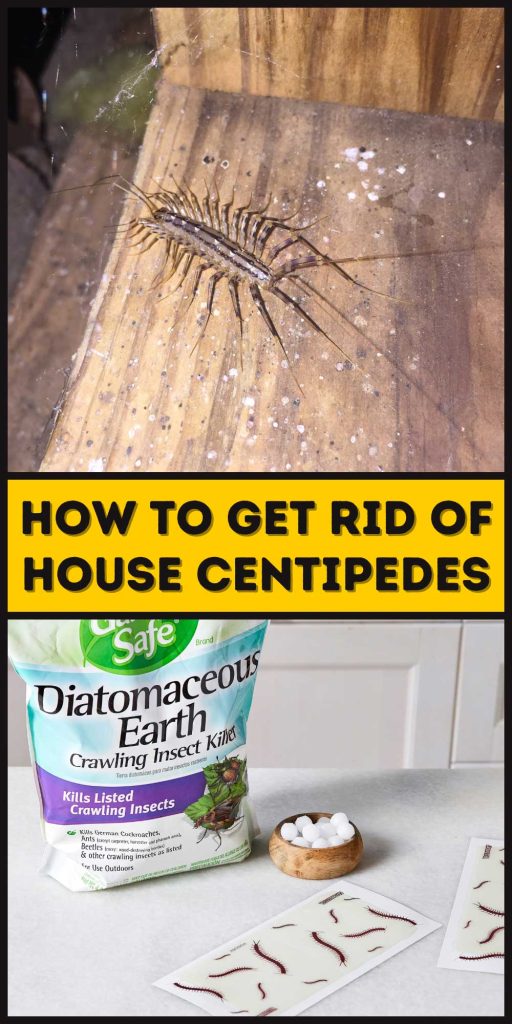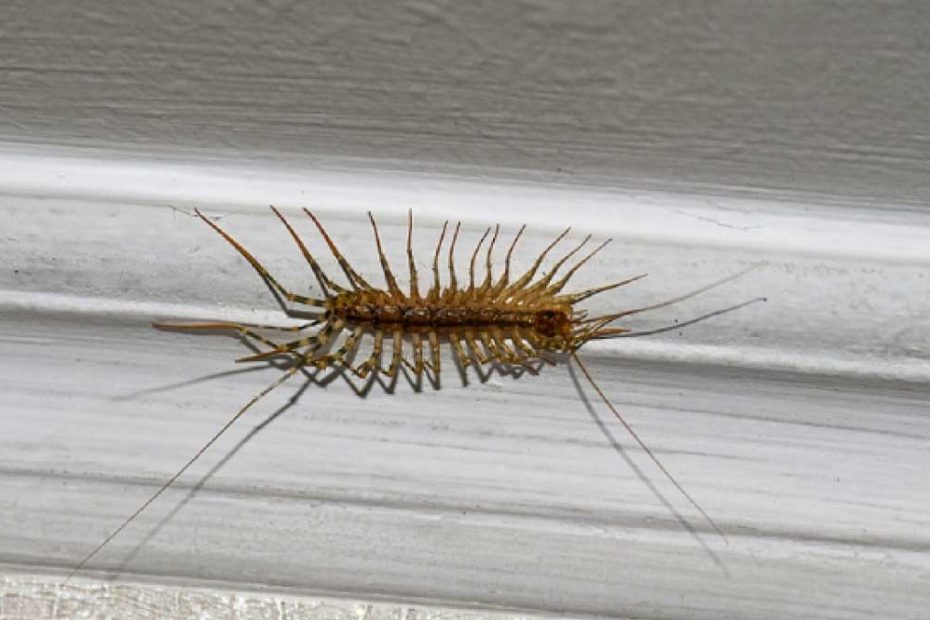You’ve just spotted a house centipede scurrying across your floor, and now you’re wondering how to get rid of these creepy crawlers. House centipedes, with their many legs and swift movements, can be alarming to see, but they don’t have to be permanent roommates.
Understanding why they’re in your home is the first step to evicting them for good. These nocturnal hunters thrive in dark, damp environments and are usually a sign of other pest problems. By addressing the underlying issues and taking some proactive measures, you can send house centipedes packing and reclaim your living space.
Key Takeaways
- Understand the Behavior and Environment of House Centipedes: Recognize that house centipedes thrive in dark, damp environments and often signify the presence of other pests.
- Identify Common Infestation Signs: Look for signs such as live centipede sightings, shed legs, and the presence of other insects they prey upon.
- Utilize Natural Repellents: Essential oils like tea tree, peppermint, and lavender can serve as effective, non-toxic deterrents.
- Deploy Sticky Traps: Place sticky traps in strategic locations such as basements, bathrooms, and under sinks to capture and monitor centipede activity.
- Consider Chemical Solutions for Severe Infestations: Use insecticides like liquid sprays, aerosol sprays, and dust insecticides, or seek professional extermination services.
- Implement Preventative Measures: Reduce moisture levels by fixing leaks and using dehumidifiers, and seal entry points by caulking cracks and installing door sweeps and fine mesh screens.

Understanding House Centipedes
House centipedes may be unsettling, but understanding them helps in effective removal. These arthropods thrive in specific environments and serve a particular role in ecosystems, even indoor ones.
Characteristics of House Centipedes
- Appearance: Long, segmented bodies with 15 pairs of long legs, allowing rapid movement.
- Size: Typically between 1 to 1.5 inches, though some can grow up to 3 inches.
- Color: Yellowish-gray with dark stripes along their body segments.
Preferred Habitats
House centipedes seek out dark, damp places where other pests are present. Common locations include:
- Basements: Humid environments ideal for centipedes.
- Bathrooms: Moisture from showers creates suitable conditions.
- Closets: Dark, quiet spaces attract centipedes.
- Kitchens: Presence of food and moisture.
Behavior and Diet
Centipedes are nocturnal, hunting at night. Their diet includes a variety of household pests:
- Insects: Silverfish, cockroaches and ants.
- Arachnids: Spiders.
- Other Arthropods: Termites and bedbugs.
Signs of Infestation
You might be dealing with a centipede problem if you notice:
- Sightings: Seeing centipedes in your home, especially at night.
- Shed Legs: Finding thin, leg-like parts around damp areas.
- Other Pests: An existing problem with other insects or spiders.
Why They Invade Homes
House centipedes enter homes seeking food and moisture sources. Factors contributing to their presence include:
- Leaks: Unresolved water leaks creating moist environments.
- Clutter: Piles of boxes or clothing providing hiding spots.
- Gaps and Cracks: Entry points through which centipedes squeeze.
Action Point
Understanding house centipedes’ preferences and behaviors helps in identifying their hiding spots and food sources. Addressing these can limit their presence, creating a less inviting environment for these pests.
Identifying Infestations
Discovering house centipedes in your home can be unsettling. Learning to identify signs of an infestation helps address the issue effectively.
Common Signs
Recognizing indications of house centipedes assists in early detection. Here are some common signs:
- House Centipede Sightings: Spotting live centipedes, particularly in dark, damp areas.
- Shed Legs: Finding legs shed by centipedes, which can detach easily.
- Other Pests: Noticing other insects like silverfish or cockroaches, potential food sources for centipedes.
Where to Look
Identify likely hiding spots for house centipedes by focusing on the following areas:
- Basements: Often damp and dark, offering ideal conditions.
- Bathrooms: Attraction to moisture makes bathrooms common habitats.
- Kitchens: Presence of food crumbs and moisture.
- Closets: Darkness and clutter provide shelter.
By staying vigilant in these areas, you can catch early signs of centipede activity and take action promptly.
Natural Methods To Get Rid Of House Centipedes
Natural methods offer effective and eco-friendly solutions for controlling house centipedes. They aim to deter these pests without using harsh chemicals. Start with these techniques to maintain a safer and cleaner home environment.
Essential Oils
Essential oils act as natural repellents for house centipedes due to their potent scents.
- Tea Tree Oil: Known for its antibacterial properties, tea tree oil can help deter centipedes. Mix 10 drops of tea tree oil with 1 cup of water, then spray the solution in areas where you’ve seen centipedes.
- Peppermint Oil: Peppermint oil’s strong scent is unpleasant to centipedes. Combine 15 drops of peppermint oil with 1 cup of water and spray the mixture around baseboards, doorways, and potential entry points.
- Lavender Oil: Lavender oil not only repels centipedes but also has a calming scent. Add 10 drops to 1 cup of water and spray in closets and other dark, damp areas.
Sticky Traps
Sticky traps provide an easy and non-toxic way to capture house centipedes.
- Placement: Position sticky traps in common centipede pathways such as basements, bathrooms, and under sinks. Place them close to walls where centipedes are likely to travel.
- Regular Checks: Monitor the traps weekly and dispose of trapped centipedes. Replace the traps every few months or as they become filled.
Using essential oils and sticky traps can significantly reduce centipede activity in your home. These natural methods not only help in controlling the centipede population but also contribute to a healthier living environment.
Chemical Solutions For House Centipedes
When natural methods aren’t enough, chemical solutions offer an effective alternative to control house centipedes. These solutions range from readily available insecticides to professional extermination services.
Insecticides
Using insecticides can significantly reduce house centipede populations. Here’s what you need to know:
Types:
- Liquid Sprays: Typically applied around baseboards, entry points, and damp areas where centipedes frequent.
- Aerosol Sprays: Convenient for quick application, especially for hard-to-reach spots.
- Dust Insecticides: Effective for long-term control in cracks and crevices.
Common Ingredients:
- Pyrethroids: Synthetic chemicals that mimic natural insecticidal compounds. Examples: Cypermethrin, Deltamethrin.
- Diatomaceous Earth: Natural powder that damages exoskeletons, leading to dehydration.
Application Tips:
- Read and follow the product label for safe use.
- Focus on areas where centipedes hide, like basements, bathrooms, and under sinks.
- Reapply as necessary to maintain effectiveness.
Professional Extermination
If the infestation persists, professional exterminators can provide comprehensive solutions. Here’s what to expect:
Inspection:
- Detailed assessment to identify the extent of the problem.
- Identification of potential entry points and hiding spots.
Treatment Plans:
- Customized approach based on your home’s needs, often combining chemical treatments with preventive measures.
- Use of commercial-grade products not available to the public.
Follow-Up:
- Scheduled visits to monitor progress and reapply treatments if needed.
- Recommendations for reducing future infestations, such as sealing cracks and removing excess moisture.
- Expertise ensures thorough eradication of centipedes.
- Safe handling of potent chemicals, reducing risks to your family and pets.
Using chemical solutions ensures a comprehensive approach to house centipede control. Employ these methods strategically to manage centipede infestations effectively.
Preventative Measures
Taking preventative measures can help keep house centipedes out of your home. Focus on reducing moisture and sealing entry points to maintain a centipede-free environment.
Reducing Moisture
House centipedes thrive in damp environments. Reducing moisture levels targets their preferred habitats.
Key Steps:
- Fix Leaks: Repair any plumbing leaks, including dripping faucets and pipes, promptly.
- Improve Ventilation: Use exhaust fans in bathrooms and kitchens to reduce humidity.
- Use Dehumidifiers: Place dehumidifiers in basements and damp areas to control humidity levels.
- Clear Gutters: Ensure gutters and downspouts direct water away from the house to prevent water accumulation.
- Inspect the Basement: Address any cracks or structural issues that allow dampness to infiltrate.
Sealing Entry Points
Sealing entry points prevents centipedes and other pests from accessing your home.
- Seal Cracks and Gaps: Use caulk to fill cracks and gaps in walls, around windows, and doors.
- Install Door Sweeps: Add door sweeps to exterior doors to block entry along the bottom edges.
- Secure Vents and Openings: Cover vents, chimneys, and other openings with fine mesh screens.
- Check Utility Lines: Seal spaces around utility lines, such as plumbing and electrical entries, with caulk or expandable foam.
- Inspect Weather Stripping: Replace any damaged weather stripping around doors and windows.
These preventative measures significantly reduce the likelihood of house centipede infestations by addressing their key living conditions and access points.
Conclusion
By understanding the habits and preferences of house centipedes, you can effectively tackle these unwelcome guests. Focus on reducing moisture and sealing entry points to make your home less appealing to them. Use natural repellents and sticky traps for eco-friendly control, and consider chemical solutions if needed. For persistent issues, professional extermination services can provide thorough and lasting results. With these strategies, you’ll create a healthier and centipede-free living environment.
Frequently Asked Questions
What attracts house centipedes to my home?
House centipedes are attracted to damp, dark environments and can indicate other pest issues. Their preferred habitats include basements, bathrooms, closets, and kitchens where moisture is prevalent.
How can I identify house centipedes?
House centipedes have long, segmented bodies measuring 1 to 1.5 inches, are yellowish-gray with dark stripes, and are nocturnal creatures that feed on household pests like silverfish, cockroaches, and spiders.
What are the signs of a house centipede infestation?
Signs of infestation include sightings of centipedes, shed legs, and the presence of other pests that serve as their food source.
Why do house centipedes invade homes?
House centipedes invade homes due to unresolved leaks, clutter, and gaps that provide entry, seeking out moisture-rich environments and food sources.
How can I naturally repel house centipedes?
Natural repellents include essential oils like tea tree, peppermint, and lavender. Mix with water and spray in affected areas. Sticky traps can also be effective in capturing centipedes.
What chemical solutions work for house centipedes?
Effective chemical solutions include liquid sprays, aerosol sprays, and dust insecticides containing pyrethroids or diatomaceous earth. Focus application on centipede hiding spots and follow product labels for safe use.
When should I consider professional extermination services?
Professional extermination services are recommended for persistent infestations, offering thorough inspections, customized treatment plans, and follow-up visits to ensure effective eradication.
How can I prevent house centipedes from entering my home?
Prevent house centipedes by reducing moisture levels and sealing entry points. Fix leaks, improve ventilation, use dehumidifiers, and fill cracks and gaps to create an uninviting environment for them.
Are house centipedes harmful to humans?
House centipedes are generally not harmful to humans. They do bite, but bites are rare and typically cause only minor discomfort. Their presence often signifies other pest issues that need addressing.
Do house centipedes provide any benefits?
House centipedes can be beneficial by preying on other common household pests such as silverfish, cockroaches, and spiders, thus helping to control those populations within the home.
